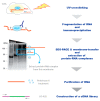Rapidly Growing Protein-Centric Technologies to Extensively Identify Protein-RNA Interactions: Application to the Analysis of Co-Transcriptional RNA Processing
- PMID: 34070162
- PMCID: PMC8158511
- DOI: 10.3390/ijms22105312
Rapidly Growing Protein-Centric Technologies to Extensively Identify Protein-RNA Interactions: Application to the Analysis of Co-Transcriptional RNA Processing
Abstract
During mRNA transcription, diverse RNA-binding proteins (RBPs) are recruited to RNA polymerase II (RNAP II) transcription machinery. These RBPs bind to distinct sites of nascent RNA to co-transcriptionally operate mRNA processing. Recent studies have revealed a close relationship between transcription and co-transcriptional RNA processing, where one affects the other's activity, indicating an essential role of protein-RNA interactions for the fine-tuning of mRNA production. Owing to their limited amount in cells, the detection of protein-RNA interactions specifically assembled on the transcribing RNAP II machinery still remains challenging. Currently, cross-linking and immunoprecipitation (CLIP) has become a standard method to detect in vivo protein-RNA interactions, although it requires a large amount of input materials. Several improved methods, such as infrared-CLIP (irCLIP), enhanced CLIP (eCLIP), and target RNA immunoprecipitation (tRIP), have shown remarkable enhancements in the detection efficiency. Furthermore, the utilization of an RNA editing mechanism or proximity labeling strategy has achieved the detection of faint protein-RNA interactions in cells without depending on crosslinking. This review aims to explore various methods being developed to detect endogenous protein-RNA interaction sites and discusses how they may be applied to the analysis of co-transcriptional RNA processing.
Keywords: CLIP; RNA polymerase II; RNA-binding protein; co-transcriptional RNA processing; tRIP.
Conflict of interest statement
The authors declare no conflict of interest.
Figures




Similar articles
-
PAR-CliP--a method to identify transcriptome-wide the binding sites of RNA binding proteins.J Vis Exp. 2010 Jul 2;(41):2034. doi: 10.3791/2034. J Vis Exp. 2010. PMID: 20644507 Free PMC article.
-
Transcriptome-wide Identification of RNA-binding Protein Binding Sites Using Photoactivatable-Ribonucleoside-Enhanced Crosslinking Immunoprecipitation (PAR-CLIP).Curr Protoc Mol Biol. 2017 Apr 3;118:27.6.1-27.6.19. doi: 10.1002/cpmb.35. Curr Protoc Mol Biol. 2017. PMID: 28369676
-
Evaluation of Post-transcriptional Gene Regulation in Pancreatic Cancer Cells: Studying RNA Binding Proteins and Their mRNA Targets.Methods Mol Biol. 2019;1882:239-252. doi: 10.1007/978-1-4939-8879-2_22. Methods Mol Biol. 2019. PMID: 30378060 Review.
-
Principles of RNA processing from analysis of enhanced CLIP maps for 150 RNA binding proteins.Genome Biol. 2020 Apr 6;21(1):90. doi: 10.1186/s13059-020-01982-9. Genome Biol. 2020. PMID: 32252787 Free PMC article.
-
Identification of RNA-protein interaction networks using PAR-CLIP.Wiley Interdiscip Rev RNA. 2012 Mar-Apr;3(2):159-77. doi: 10.1002/wrna.1103. Epub 2011 Dec 27. Wiley Interdiscip Rev RNA. 2012. PMID: 22213601 Free PMC article. Review.
Cited by
-
MPI-VGAE: protein-metabolite enzymatic reaction link learning by variational graph autoencoders.Brief Bioinform. 2023 Jul 20;24(4):bbad189. doi: 10.1093/bib/bbad189. Brief Bioinform. 2023. PMID: 37225420 Free PMC article.
-
Tex13a Optimizes Sperm Motility via Its Potential Roles in mRNA Turnover.Front Cell Dev Biol. 2021 Oct 18;9:761627. doi: 10.3389/fcell.2021.761627. eCollection 2021. Front Cell Dev Biol. 2021. PMID: 34733855 Free PMC article.
-
Regulated splicing of large exons is linked to phase-separation of vertebrate transcription factors.EMBO J. 2021 Nov 15;40(22):e107485. doi: 10.15252/embj.2020107485. Epub 2021 Oct 4. EMBO J. 2021. PMID: 34605568 Free PMC article.
-
Towards an Ideal In Cell Hybridization-Based Strategy to Discover Protein Interactomes of Selected RNA Molecules.Int J Mol Sci. 2022 Jan 15;23(2):942. doi: 10.3390/ijms23020942. Int J Mol Sci. 2022. PMID: 35055128 Free PMC article. Review.
-
Complexome Profiling: Assembly and Remodeling of Protein Complexes.Int J Mol Sci. 2021 Jul 21;22(15):7809. doi: 10.3390/ijms22157809. Int J Mol Sci. 2021. PMID: 34360575 Free PMC article. Review.
References
Publication types
MeSH terms
Substances
Grants and funding
- JP18K06058, JP21H02476, JP19K22802, JP20H03561, and JP16H06279 (PAGS)/Japan Society for the Promotion of Science
- 20FC1036/Ministry of Health, Labour and Welfare
- JP20gm1010002, JP20ek0109488, and JP20bm0804005/Japan Agency for Medical Research and Development
- Naito Foundation
- The Intramural Research Grant for Neurological and Psychiatric Disorders of NCNP (2-5)/National Center of Neurology and Psychiatry
LinkOut - more resources
Full Text Sources

